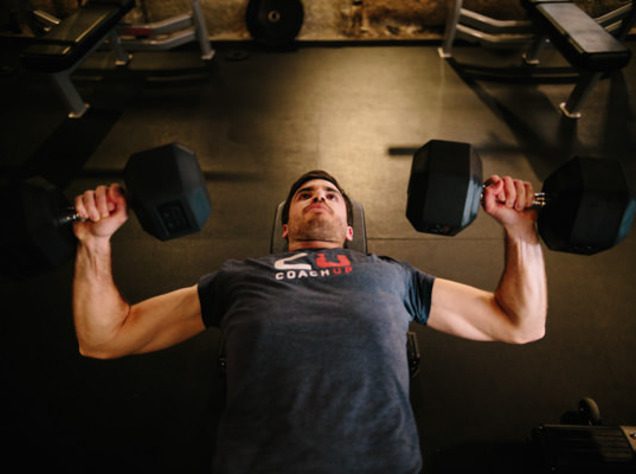Utilizing The Bench Press
It should go without saying, but one of the key components of strength and conditioning is weight training. Even further, the bench press is a crucial asset of any aspiring athlete’s regimen — if you’re playing sports, you should consider hopping on the bench sooner rather than later. In fact, this exercise could probably be called the Gym Rat’s best friend because this lift is most associated with raw strength gain. However, most assume that they can just hop on the equipment and start seeing immediate gains, but that couldn’t be further from the truth.
Simply put, you must diligently focus on your form, technique, and discipline before seriously working with any heavy external load. As always with heavy lifting exercises, CoachUp must stress that safety is more important than any potential gain or achievement. Please, make sure you’re only lifting what you’re comfortable and prepared for, it’s not worth the inherent injury. Additionally, grab a partner, coach, parent, or trainer before attempting the bench press as having a knowledgeable spotter is mandatory as well. Ultimately, you must understand that the bench is not as simple as just moving the bar up and down. On top of that, your gains will be shortsighted and dangerous if you don’t take a diligent and safe approach to the exercise. Keeping those ideals and focuses in mind, here is CoachUp’s strategy behind the bench press.

The Bench Press
Begin by lying flat on the bench. From this position we’ll start making some small tweaks Think about lying in your bed, your body should be in a neutral and relaxed position. Furthermore, it’s very important to make sure your back is relaxed in its natural curve. This means that your lower back should not be touching the bench with your feet flat on the floor. Remember, half the battle is putting yourself in a place to succeed, so don’t be lazy or cut corners. Next, put your arms out to either side of you, bend them 90 degrees, and then bring them up to the bar. This is where you should grab the bar naturally without much adjustment.
However, if you’re looking to target your pectoral muscles, go with slightly wider grip. Additionally, if you’re looking to target your triceps, opt for a slightly narrower grip. When you first begin, practice with just the bar. You will first need to lift the bar off the rack and position it over the middle of your chest over and over effectively before graduating to the heavy, potentially harming, weight loads. With that in mind, with weight or without, once the bar is steady, proceed to pinch your shoulder blades together. This little move will shorten the length from your chest to the bar and prevent pectoral tears.
Take a big breath in as you start to let the bar descend towards your chest. As the bar comes into contact with your chest, do not let it bounce, but instead keep control. If you’re not careful, this bounce can cause a serious injury. Begin to exhale and push the bar upwards. One cue CoachUp likes to use is to spread the bar — when we say this, try to pull apart the bar. If done correctly, this will create an upward motion. Finally, you will want to lock the bar out on every rep for consistency. The bench press is a very complex movement and requires many muscles.
The muscles listed below are in order of alleged importance, that way, you can focus on whatever areas you most need help in. Feel free to modify so you’re getting the most out of your exercises! Try working on your muscles through this cycle: triceps, deltoids, latissimus dorsi, pectorals, and then the biceps and forearms.
(Related: Read about weight lifting for weight loss here.)
Huddle Up
Ultimately, like any good weight lifting exercise, the power is in your own hands. If you use the bench sparingly, like two or three times a month, you won’t see any gains. But if you use it too frequently, you run the risk of damaging your muscles, so be careful. Furthermore, only correct form and technique at the appropriate level with help you towards achieving your goals, so don’t try to cut corners or add too much external weight! Lifting weights is not a race, so understand your body, your max limits, and work at creating reasonable goals while being safe and in good form. Believe us, your body will thank you later.
However, if you’re still struggling with your abilities under the bar, consider booking one of CoachUp’s private trainers so guide you along the way. So, whether it’s your form or technique, or you just need a lifting partner, we’re here to help. Our team will help you create the your best, personal workout while staying safe and strong — so what are you waiting for?
How useful was this post?
Click on a star to rate it!
Average rating 0 / 5. Vote count: 0
No votes so far! Be the first to rate this post.



